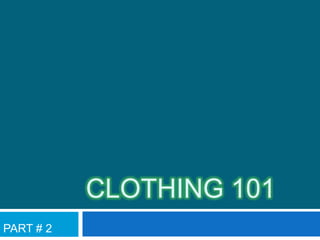Clothing 101 part2
•Télécharger en tant que PPTX, PDF•
2 j'aime•530 vues
Signaler
Partager
Signaler
Partager

Recommandé
Recommandé
Contenu connexe
Similaire à Clothing 101 part2
Similaire à Clothing 101 part2 (20)
the old stone age, paleolithic and mesolithic.pptx

the old stone age, paleolithic and mesolithic.pptx
Dimpal chouhan , Fashion Design Student NSQF Level -5

Dimpal chouhan , Fashion Design Student NSQF Level -5
Kriti Tolani ,Fashion Design ,Dezyne E'cole College

Kriti Tolani ,Fashion Design ,Dezyne E'cole College
Plus de Kermit Agbas
Plus de Kermit Agbas (14)
Dernier
https://app.box.com/s/7hlvjxjalkrik7fb082xx3jk7xd7liz3TỔNG ÔN TẬP THI VÀO LỚP 10 MÔN TIẾNG ANH NĂM HỌC 2023 - 2024 CÓ ĐÁP ÁN (NGỮ Â...

TỔNG ÔN TẬP THI VÀO LỚP 10 MÔN TIẾNG ANH NĂM HỌC 2023 - 2024 CÓ ĐÁP ÁN (NGỮ Â...Nguyen Thanh Tu Collection
Dernier (20)
TỔNG ÔN TẬP THI VÀO LỚP 10 MÔN TIẾNG ANH NĂM HỌC 2023 - 2024 CÓ ĐÁP ÁN (NGỮ Â...

TỔNG ÔN TẬP THI VÀO LỚP 10 MÔN TIẾNG ANH NĂM HỌC 2023 - 2024 CÓ ĐÁP ÁN (NGỮ Â...
NO1 Top Black Magic Specialist In Lahore Black magic In Pakistan Kala Ilam Ex...

NO1 Top Black Magic Specialist In Lahore Black magic In Pakistan Kala Ilam Ex...
Python Notes for mca i year students osmania university.docx

Python Notes for mca i year students osmania university.docx
Basic Civil Engineering first year Notes- Chapter 4 Building.pptx

Basic Civil Engineering first year Notes- Chapter 4 Building.pptx
Micro-Scholarship, What it is, How can it help me.pdf

Micro-Scholarship, What it is, How can it help me.pdf
ICT role in 21st century education and it's challenges.

ICT role in 21st century education and it's challenges.
ICT Role in 21st Century Education & its Challenges.pptx

ICT Role in 21st Century Education & its Challenges.pptx
Fostering Friendships - Enhancing Social Bonds in the Classroom

Fostering Friendships - Enhancing Social Bonds in the Classroom
Clothing 101 part2
- 1. CLOTHING 101 PART # 2
- 2. INTRODUCTION The record’s of man’s use of Textiles, dates back thousands of years before the birth of Christ. Our knowledge of the early development in textiles is very meager as they are not evident through proper records. Textiles were first developed as a means for carrying food and as mats in shelter. Only in later stages it is used as clothing.
- 3. EARLY USE OF CLOTHES When early people realized they needed more than their own hair and skin to protect them from the weather, they looked around to see what was available. People lived in a cold climate, saw animals with skins that kept them warm. They hunted these animals for food and used the fur to cover their body.
- 4. EARLY DEVELOPMENT OF SEWING AND FABRIC: Once they started to hunt they used the skin of animals as clothes. This skin when continuously used becomes harder and made difficult for them to hunt. For this purpose he started to treat the skin to preserve its softness. Later the bones of animals were used as needle and nerves were used as thread to stitch the hides.
- 5. Ancient people used Grasses, reeds, leaves and stems to cover their body. He also learned to spin the fiber, convert it into yarn and these yarns are interlaced to form a cloth. Flax and wool were the first of the fiber to be used because they were easier to twist into yarn than cotton. They also used the hair of animals as bed, in due course, these hair tangled with each other and formed as a fabric. This method is only followed while making felt cloth.
- 6. After thousands of years of wandering, people learned that they could live in one place with other humans and grow what they needed. This is known as an agrarian society. People learned how to raise certain animals for the meat and the skins. They learned to grow certain plants for food. People no longer had to spend all their time hunting and farming.
- 7. People learned how to spin bits of plants, reeds, horse hair, and bark into one continuous strand, or yarn. Then they discovered how to take these long pieces of yarn and weave them into fabric, just like they wove the grasses. People began to look around for other fibers they could use to make yarn. The cotton, wool, silk, and flax that they found are still the most common natural fibers today.
